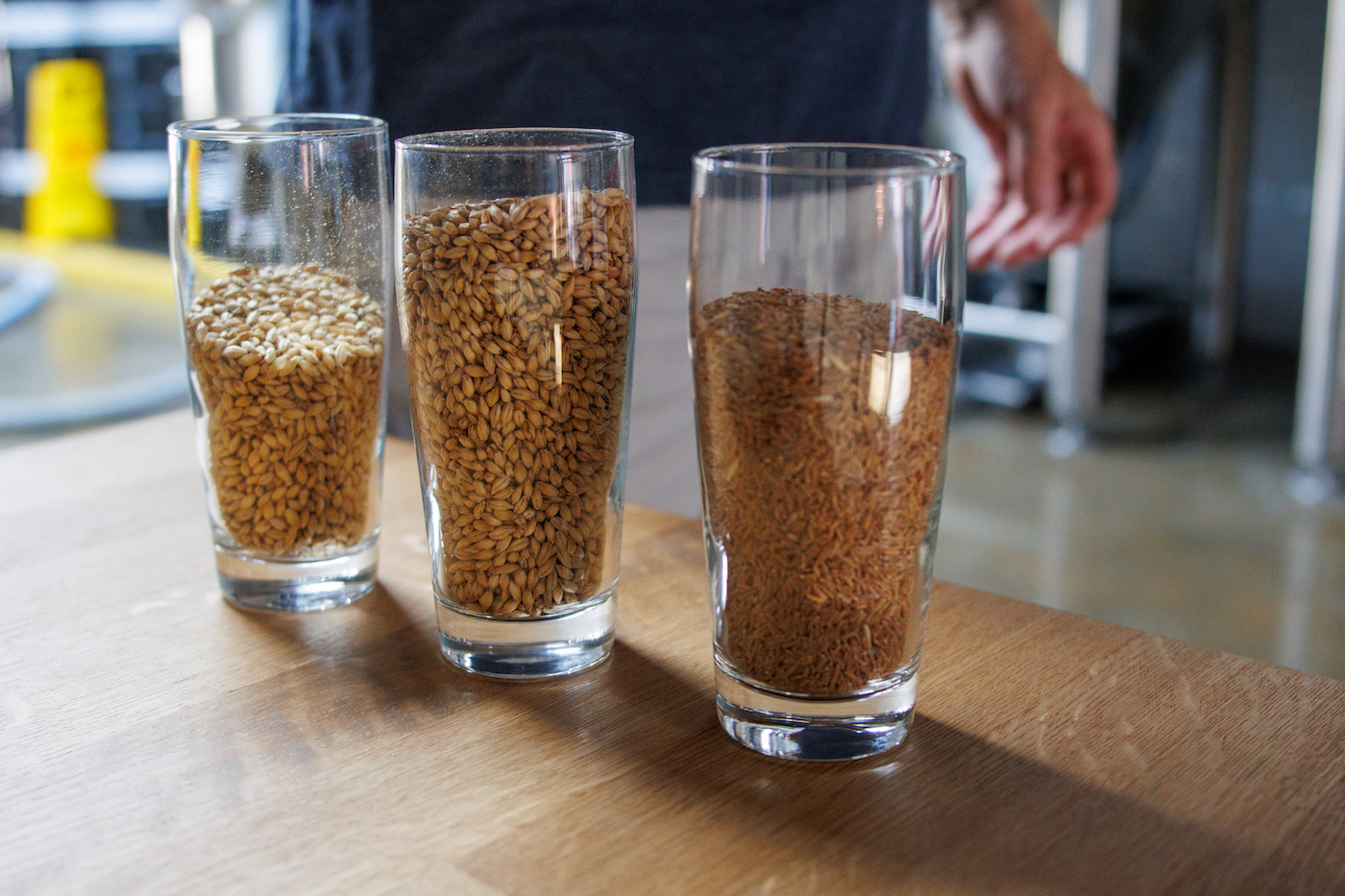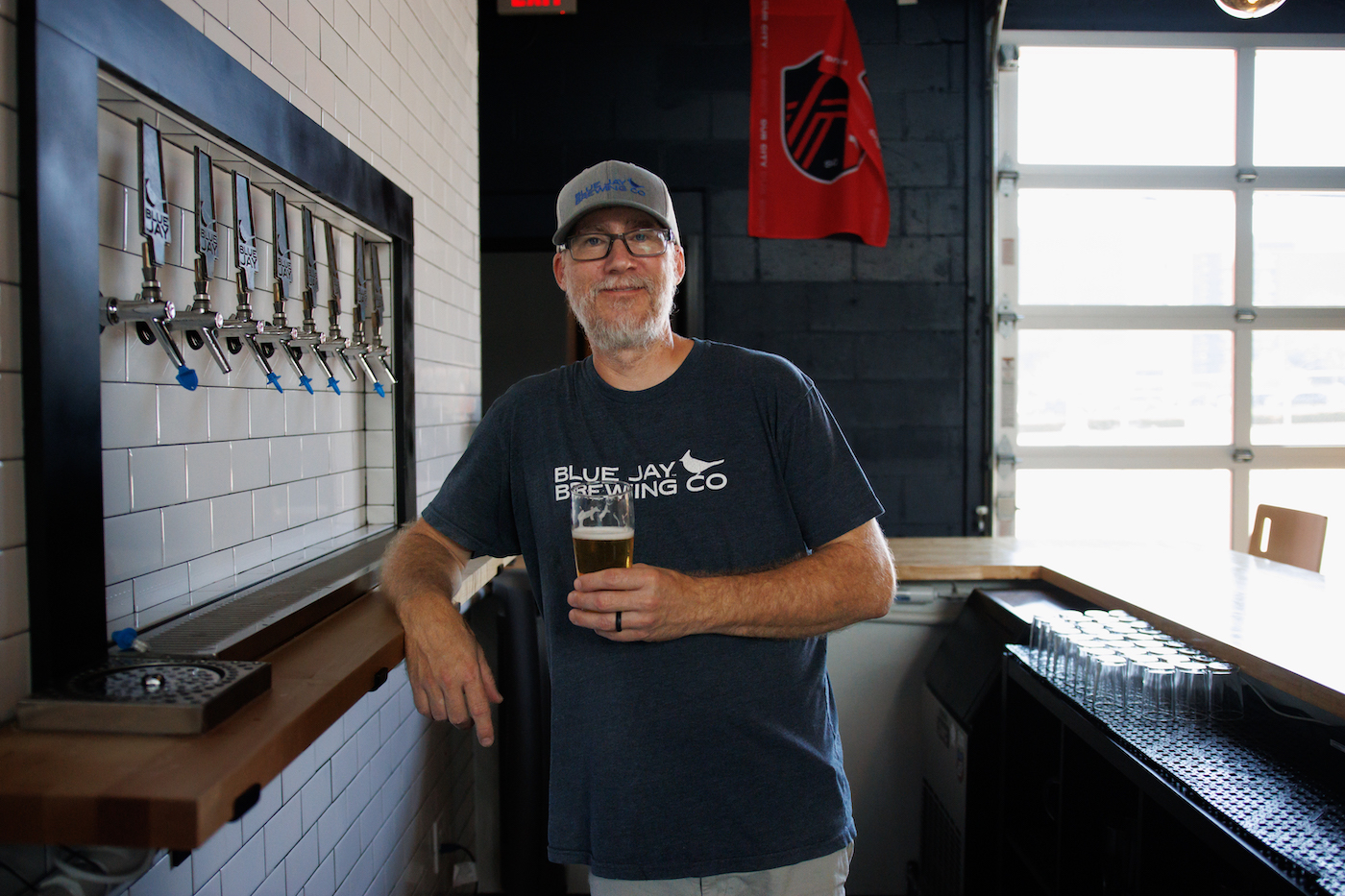Scientists Push For A Lesser-Known Grain Called Kernza
4:16 minutes


This article is part of The State of Science, a series featuring science stories from public radio stations across the United States. This story, by Eric Schmid, was originally published by St. Louis Public Radio in partnership with the Mississippi River Basin Ag & Water Desk.
On a recent weekday afternoon, dozens of people filled the cozy taproom at Blue Jay Brewing Company. Scattered among the tables and bar were glasses filled with the lagers that are a specialty of this St. Louis brewery.
Also on tap that day was a fresh creation called New Roots. The American Lager was a hit, with many of the patrons going back to the bar for another glass.
“I love it—nice earthiness. Still nice and crushable though,” said Bryan Schubert, who owns a brewery in Illinois. “That is, in reality, a good measure of beer. You want somebody to be in your taproom and be able to enjoy a few of them within reason.”
It was good enough that regulars like Greg Campbell were giving it a try in addition to what they usually order.
“It’s hard for me to leave my favorite German beer. I did try some [New Roots] and said, ‘Man, that’s spot on,’” he said. “It’s full bodied, very balanced and [has a] good flavor.”

Blue Jay’s owner and brewer, Jason Thompson, was also pleased with the result of this experimental beer, which he described as “earthy, almost nutty,” with a “lingering honey-like sweetness to it.”
Those flavors came from his choice to use a novel grain called Kernza for 25% of the 600 pounds of grain needed for the whole brew, he said.
“Any grain I haven’t used before, I find interesting and challenging,” Thompson said. The Kernza kernel is much smaller than a barley or wheat kernel, he added, “kind of elongated and skinny. Almost flat.”
Those differences did pose a few challenges. Thompson explained the Kernza slipped right through his mill when he tried to crush the kernels to expose the starch that’s necessary for brewing.
In the end, Thompson adjusted to a different brewing technique that used a mix of milled and unmilled Kernza and the experiment worked. That was good news for Thomson but also for Kernza advocates who want the grain to succeed and see in its small seeds potentially huge changes to modern agriculture.

Many agricultural staples today, like corn, soy, wheat, barley and others, are planted into the ground each growing season. After harvest, the soil is left bare or farmers plant cover crops in those fields over the winter. Kernza, by contrast, stays in the ground for several years, and can produce multiple harvests in that time.
“It has a very deep, persistent root system that stays in the ground for multiple years–the life of the plant,” said Allison Miller, an evolutionary biologist who studies Kernza at the Donald Danforth Plant Science Center. “It holds soil in place, helps build new soil, absorbs water, takes up nutrients, hosts a hugely diverse microbiome, and it also sequesters carbon.”
This kind of a plant becomes particularly appealing when searching for potential crops that can both feed people and mitigate the negative effects of farming on the planet, she added.
There are thousands of perennial plant species that could be developed for agriculture. Plant researchers recently found that a perennial rice maintained better soil quality, required less labor and delivered comparable yield compared to an annual rice variety.
The hope is Kernza could perform similarly. But it and other potential perennial crops face an evolutionary challenge, Miller said. Kernza comes from Intermediate wheatgrass, a perennial grass native to Central Asia that was first introduced in the U.S. in the 1930s. It was primarily used as a forage grass and crop researchers only began breeding it as a food source for people in the 1980s.
“Kernza is essentially at a 10,000 year disadvantage relative to other major crops,” Miller said. “We don’t really think we have 10,000 years to develop the future of agriculture. We really want that happening within the next century. And hopefully earlier than that.”
Miller’s research seeks to bridge that gap by studying the ways perennial plants grow and allocate resources to different parts of the plant body. Understanding that could help scientists more quickly breed a plant that could produce larger seed yields and still develop the root system that’s essential for the environmental benefits, she said. Still, she acknowledged her research is a long term project.
“This is not something that we could go this fall and say, ‘You know next year I’d really like to shift this soybean field to Kernza,’” she said. “That’s going to be a challenge at the scale of contemporary agriculture.”
But the kind of experimentation happening at Blue Jay Brewing Company is an important step in the development of alternative grains to wheat, barley and other annual crops, said Miller.

Kernza, which first hit the market in 2018, occupied 2,405 acres of U.S. farmland in 2023 out of the hundreds of millions acres planted across the country. Some farmers want to access the environmental benefits from growing Kernza but the consumer market for it isn’t quite there, said Tessa Peters, director of crop stewardship at The Land Institute, which develops perennial crops including Kernza.
There also aren’t many entities in the middle of the supply chain set up to mill or process the grain, making it all the more difficult for individuals or food and beverage companies of any size to use Kernza, Peters said.
“The market is soft and unpredictable because it’s so early,” she said. “And it’s worth saying the price has been a barrier. The yields are lower than wheat—we’re working on that.”
Environmental arguments likely aren’t going to push many people to buy or consume the product, Peters added.
“Consumers don’t really purchase based on environmental messaging,” she said. “That’s where I think Kernza really has an edge because it actually tastes great and makes delicious products.”
She argued that if a large food conglomerate, like General Mills or Nestle, committed to using a tiny amount of Kernza in a few of their most popular products, the grain’s fortunes could quickly change.
“A few big companies who put 1-5% of Kernza in their best selling products could translate to tens or hundreds of thousands of acres,” she said. “Those big players have a lot of sway with the supply chain.”
But small brewers, like Blue Jay and others that are experimenting with using Kernza still have a critical role to play, she said. They are entities that have a close connection with their consumers and can help introduce the story behind Kernza.
“These companies have the opportunity to be the shepherds that bring bigger companies in and say, ‘[Using Kernza] can be done effectively and at a price point that makes sense,’” she said.
Nick Colombo, an owner at Switchgrass Spirits in St. Louis, which makes bourbons, whiskeys and other spirits, agreed. Like Blue Jay Brewing, his small distillery is just beginning to experiment with Kernza.
“We can do something fun and exciting,” he said. “Big corporate whiskey is never going to do that because they have to maximize profits for their shareholders.”
So while Switchgrass won’t sway the market through their purchasing power, he said, “I could see [Kernza use] growing if the name gets out there, if the demand is there, if we create a customer base.”
But that is still years away.
“We’re working with these other craft beverage manufacturers to figure out how to convert Kernza to alcohol and what it tastes like,” he said. “We’ve honestly just never had access to Kernza, it’s hard to buy.”
It’s a dilemma Thompson also faced. He tapped into special connections to get the hundreds of pounds of Kernza he needed for the recent batch of New Roots. But Thompson was clear that he’d brew with the grain again.
“I would like to, it depends on the availability of Kernza,” Thompson said.
Keep up with the week’s essential science news headlines, plus stories that offer extra joy and awe.
Eric Schmid is the economic development reporter at St. Louis Public Radio in St. Louis, Missouri.
KATHLEEN DAVIS: This is Science Friday. I’m Kathleen Davis. And now, it’s time to check in on the State of Science–
SPEAKER 1: This is KERA News.
SPEAKER 2: For WWNO–
SPEAKER 3: Saint Louis Public Radio.
SPEAKER 4: KKRA News.
SPEAKER 5: Iowa Public Radio.
KATHLEEN DAVIS: –local science stories of national significance. Corn and soybeans are two of the most produced crops in the United States. They’re grown on more than 170 million acres of farmland. But these crops need to be replanted each year, which can cause problems with the soil. Some plant scientists are serving up an alternative, a grain called Kernza, which can live in the ground for several years. Here with more is my guest, Eric Schmid, Economic Development Reporter at Saint Louis Public Radio in Missouri. Eric, welcome back to Science Friday.
ERIC SCHMID: Thanks so much for having me. It’s a pleasure to be here.
KATHLEEN DAVIS: Eric, what is Kernza?
ERIC SCHMID: So Kernza is the grain that comes from intermediate wheat grass. So intermediate wheatgrass is the plant. And Kernza is those little tiny kernels that would be harvested to make flour or to go into beer or any other types of products.
KATHLEEN DAVIS: So what are some of the advantages of growing Kernza over some other grains that we might be more familiar with?
ERIC SCHMID: Many of the crops that we have growing in our land today are planted every year. There are these things called annual crops. Kernza is a perennial crop. It stays in the ground every single year. So it doesn’t have to be replanted. This means that it can grow really deep roots, persistent roots, that hold the soil in place. They make new soil. They can absorb water, take up extra nutrients, sequester carbon, even host a really diverse microbiome. I spoke with Allison Miller, who’s a plant scientist at the Donald Danforth Plant Science Research Center, and she’s somebody who studies Kernza for its applications into the future.
ALLISON MILLER: When we’re looking for crops that both feed people, but also help mitigate some of the effects of people on the planet, something like this long lived relative of wheat is really appealing.
KATHLEEN DAVIS: The real question is, what does it taste like?
ERIC SCHMID: In the beer that I tried for this story, it just tasted really good. And actually, I think the head brewer who made that, Jason Thompson at Blue Jay Brewing, says it better than me.
JASON THOMPSON: It’s got a little bit different mouthfeel, I think, than barley beers, for sure. And it’s definitely earthy, almost nutty.
ERIC SCHMID: And that’s the same that I found when I baked with it. I baked a challah bread with half Kernza flour and half white flour, and it just tasted really good. I don’t know how else to describe it than just a little bit more full-bodied and kind of sweet and nutty.
KATHLEEN DAVIS: How common is Kernza at the moment?
ERIC SCHMID: Yeah, it’s not very common at the moment at all. The Land Institute, which helped develop the grain for commercial application, they take a survey every single year. And last year they found it’s only on about 2,500 acres out of hundreds of millions that are farmed across the country. And part of that problem is there’s just not a lot of consumer demand for the grain, partly because it’s not really well known. Tessa Peters is the Director of Strategy at the Land Institute, and she has some thoughts on how that can change.
TESSA PETERS: Consumers don’t really purchase based on environmental messaging. There’s a small percentage of consumers that do, but generally speaking. So I think that’s where Kernza really has an edge because it actually tastes great.
ERIC SCHMID: And what Peters also says is that it could really benefit if a few large food conglomerates or food companies, say like General Mills, for example, if they were to put a very small percentage of Kernza in some of their best-selling products, it could create more of a demand in the marketplace to grow, to process, to bring Kernza to the place where more consumers could give it a shot. I bought it after I had spoken to Allison Miller for this story, and it didn’t arrive until basically when the story was published. And that was almost a month.
KATHLEEN DAVIS: Well, Eric, thanks so much for joining us.
ERIC SCHMID: Thank you for having me.
KATHLEEN DAVIS: Eric Schmid is an Economic Development Reporter at Saint Louis Public Radio in Missouri. His story was produced in partnership with the Mississippi River Basin Ag and Water Desk.
Copyright © 2024 Science Friday Initiative. All rights reserved. Science Friday transcripts are produced on a tight deadline by 3Play Media. Fidelity to the original aired/published audio or video file might vary, and text might be updated or amended in the future. For the authoritative record of Science Friday’s programming, please visit the original aired/published recording. For terms of use and more information, visit our policies pages at http://www.sciencefriday.com/about/policies/
Kathleen Davis is a producer and fill-in host at Science Friday, which means she spends her weeks researching, writing, editing, and sometimes talking into a microphone. She’s always eager to talk about freshwater lakes and Coney Island diners.
Rasha Aridi is a producer for Science Friday. She loves stories about weird critters, science adventures, and the intersection of science and history.